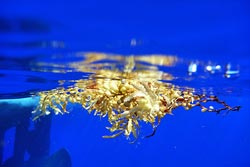Big changes in the Sargasso Sea

Small rafts of Sargassum seaweed like this one are a common site in the Sargasso Sea. These rafts harbor a variety of small animals. Image: Debbie Nail Meyer © 2011 MBARI
A recent paper by MBARI researcher Crissy Huffard and others shows that in 2011 and 2012 this animal community was much less diverse than it was in the early 1970s, when the last detailed studies were completed in this region.
This study was based on field research led by MBARI Senior Scientist Ken Smith, using the Lone Ranger, a 78-meter (255-foot) research vessel owned and operated by the Schmidt Ocean Institute. During three cruises in 2011 and 2012, Smith’s team steamed across the Sargasso Sea and used dip nets to collect samples of Sargassum seaweed (and its associated animals) at six different locations. They then classified and counted all the animals at each site.
The researchers chose their sampling and counting methods carefully so that they could compare their results with previous surveys that had been conducted in 1972 and 1973 in the same general part of the Sargasso Sea. Amazingly, the researchers could find no other studies between 1973 and 2011 during which scientists had systematically counted the Sargassum animal communities in this area.
When the team analyzed the data from the recent cruises, they were surprised to find that animal communities in the Sargassum rafts were significantly less diverse than those observed in the 1970s. For example, 13 species of animals in several different groups (worms, nudibranchs, crustaceans, and sea spiders) were observed in the historical samples but were missing from the recent samples.
Unfortunately, the researchers did not have enough data to determine whether the differences they observed were the result of long-term shifts in ocean conditions in the Sargasso Sea or natural variations from place-to-place, month-to-month, or year-to-year.
The authors note that ocean conditions were much cooler than normal during February 2011 and that there were large differences in animal communities observed just six months apart, in August 2011 and February 2012. So it is possible that this area routinely sees large natural variations in the types of animals present. As Huffard put it, “If this is a long-term decline [in biodiversity], then it is a very significant one. But we don’t know if this is part of the natural variability in this community.”
Previous studies indicate that much of the seaweed that ends up in the Sargasso Sea originates in the Gulf of Mexico and is carried into the central Atlantic by the Gulf Stream and other currents. This suggests that, in addition to local ocean conditions, large-scale variations in ocean currents and conditions in the Gulf of Mexico could affect the animals in Sargassum communities.
To tease out these confounding variables, Smith and Huffard are hoping to conduct a series of follow-up expeditions to the Sargasso Sea. They plan to focus on the northern part of the Sargasso Sea, near Bermuda, where more detailed historical data are available. They are presently working on a proposal for a grant that would allow them to analyze satellite imagery and collect field samples twice a year for three years. The proposed study would show how much year-to-year variability is normal for this region.
At first glance, the animals that live in Sargassum rafts seem isolated from the rest of the world. But, like the seaweed they live in, these animal communities have many links to larger ocean food webs. For example, Sargassum animals provide essential food for sea birds, sea turtles, and bluefin tuna—all long-distance migrators. In fact, Sargassum rafts have been designated as “essential fish habitat” by the South Atlantic Fishery Management Council.
The world’s oceans are changing, with water temperatures and ocean acidity on the rise and oxygen concentrations on the decline. In the Sargasso Sea, as in many other locations, detecting the biological effects of these long-term trends is a formidable challenge because animal communities can vary dramatically over short time periods. This study shows that animal communities in the Sargasso Sea are definitely changing. The next step is to find out why.
###
For additional information or images relating to this news release, please contact:
Kim Fulton-Bennett
831-775-1835, kfb@mbari.org
Original journal article:
C.L. Huffard, S. von Thun, A.D. Sherman, K. Sealey and K.L. Smith, Jr. (2014) Pelagic Sargassum community change over a 40-year period: temporal and spatial variability. Marine Biology, doi10.1007/s00227-014-2539-y.
Media Contact
All latest news from the category: Ecology, The Environment and Conservation
This complex theme deals primarily with interactions between organisms and the environmental factors that impact them, but to a greater extent between individual inanimate environmental factors.
innovations-report offers informative reports and articles on topics such as climate protection, landscape conservation, ecological systems, wildlife and nature parks and ecosystem efficiency and balance.
Newest articles

Nerve cells of blind mice retain their visual function
Nerve cells in the retina were analysed at TU Wien (Vienna) using microelectrodes. They show astonishingly stable behavior – good news for retina implants. The retina is often referred to…

State-wide center for quantum science
Karlsruhe Institute of Technology joins IQST as a new partner. The mission of IQST is to further our understanding of nature and develop innovative technologies based on quantum science by…

Newly designed nanomaterial
…shows promise as antimicrobial agent. Rice scientists develop nanocrystals that kill bacteria under visible light. Newly developed halide perovskite nanocrystals (HPNCs) show potential as antimicrobial agents that are stable, effective…



